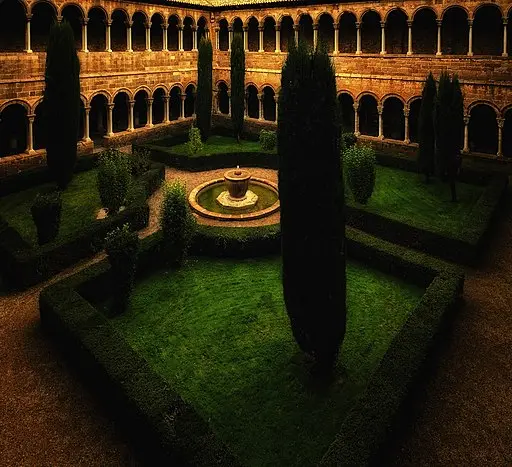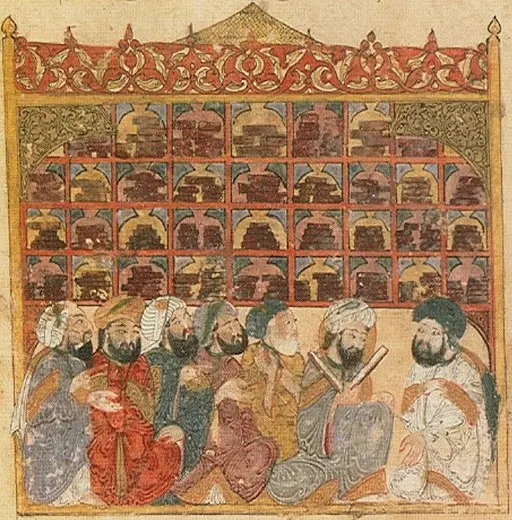 Ripoll Monastery Cloister.
Ripoll Monastery Cloister.Foto: José Luis Mieza, CC BY 2.0, via Wikimedia Commons
The importance of the monasteries in producing copies and translations of existing classical works is well known. The invasions of the Western Empire by the Nordic peoples that began in the early 5th century destroyed the imperial libraries spread over much of Italy. Many of their volumes, containing the great Latin classical tradition, were preserved in private libraries. Important repositories of classical books together with Latin ecclesiastical texts were established in Christian communities.
Throughout the Middle Ages, from the foundation of Montecasino (529) until the 15th century, the libraries of Western Europe were exclusively ecclesiastical, belonging to monasteries or cathedrals, and, from the 13th century onwards, to universities. The Benedictine rule, with its prescriptions obliging reading and writing, laid the foundations of the scriptorium and the library that existed in all the monasteries that the order spread throughout Europe.
It is in the monasteries that we find the first reference to chess in the West, Versus de scachis
, in the Benedictine abbey of Einsiedeln (Switzerland), with strong links to the Ottonian dynasty of the Holy Roman Empire, who had a relationship with Gerbert of Aurillac, Pope Sylvester II, who studied at the Monastery of Santa Maria de Ripoll.
With almost no communications in the Late Middle Ages and very little in the High Middle Ages, communications between monasteries were very important, and translations from the monastery of Ripoll were used, for example, in the abbey of Reichenau, on Lake Constance. We must think that practically until the beginning of the 12th century, and the revitalisation of trade in the 13th century, the usual mode of travel was between monasteries, rather than between towns.
The situation in the East dragged on for a few centuries, and from Constantine to Justinian several libraries were organised, in Asia Minor, Alexandria, Palestine, Athens, the monasteries of Mount Athos, and above all, the Imperial library in Constantinople. These libraries suffered multiple fires and invasions, usually destructive. The imperial library was the most important, with some 100_000 copies. But after two major fires in the 5th and 8th centuries, it was plundered by the Croatian Franks and Venetians during the Fourth Crusade in the early 13th century. The Imperial Library, a centre for the preservation of mainly Greek writings, disappeared definitively with the invasion of Constantinople in the 15th century, although it is still the most important source of Greek classics that have survived to the present day.
Even considering the importance of Constantinople, with an important task of conservation and copying of manuscripts for their preservation, it was not an important centre for the generation of new documents, nor for the dissemination of existing ones, as it did not have a school or university, and there is no record of it being a public library; the Neoplatonic school in Athens was closed and its scholars persecuted by Justinian. The contents generated by the Eastern Roman Empire since Justinian were very meagre. For example, chess is considered to have been played in Constantinople, and some testimonies attest to this, but references are practically non-existent. By the 10th century, Damascus, Baghdad or Córdoba were of greater cultural importance, as they had accumulated most of the originals, which were copied in Arabic, and were the centres of cultural production and dissemination. Estàtua d'Al-Suli en Aixkhabad (Turkmenistan)
Estàtua d'Al-Suli en Aixkhabad (Turkmenistan)
The Sassanid empire (226-651) had three centres of education, at Ctesiphon, Resaena, but mainly the academy of Gundeshapur, which became the intellectual centre of the empire in the time of Khosrow I, offering refuge to the Hellenistic intellectuals of the Neoplatonic school of Athens, persecuted by Justinian I in 529. This school also made many translations into Pahlavi, Sassanid Persian.
In 825, with Persia under Muslim rule, the House of Wisdom
or Great Library of Baghdad
was established, emulating the academy of Gundeshapur; in fact, the academic centre of Baghdad drew on the scholars of Gundeshapur, beginning the rapid decline of the Persian academy. The Great Library of Baghdad
is considered the first university in history, and acted as a centre for the dissemination of Islamic thought during the Golden Age of Islam. Its scholars also acted as civil servants, serving as physicians, architects and political advisors, among others. It was destroyed by the Mongols during the siege of Baghdad (1258).
Many well-known scholars wrote books on the Shatranj in this golden age:
- Al-Suli, with the complete name Abū Bakr Muḥammad ibn Yaḥyā ibn al-'Abbās al-Ṣūlī (أبو بكر محمد بن يحيى بن العباس الصولي) wrote:
- Kitāb al-Shiṭranj al-Nisḥa al-Awala (كتاب الشطرنج النسحة الاولة)
First version of chess book
. - Kitāb al-Shiṭranj al-Nisḥa ath-Thānīa (كتاب الشطرنج النسحة الثانية)
Chess book second edition
.
- Al-Lajlaj, alumne d'Al-Suli, with the complete name Abu al-Faraj Muhammad ibn Ubaid Allah al-Lajlaj (ابو الفرج محمد بن عبيد الله اللَجْلاج) wrote Manṣūbāt al-Shiṭranj (منصوبات الشطرنج)
Chess positions
. - Al-Adlī (العَدْلى): Kitāb al-Shiṭranj (كتاب الشطرنج)
Chess book
. - Al-Rāzī (الرازى): Kitāb latīf fī al- Shiṭranj (كتاب لطيف في الشطرنج)
A good chess book
.
 Miniature of the Al-Hariri Maqamat (collection of tales)
Miniature of the Al-Hariri Maqamat (collection of tales)
Credit: Zereshk, Public domain, via Wikimedia Commons
From the 9th century onwards, an important network of libraries spread throughout the Islamic world: Baghdad, Cairo, Alexandria, Cordoba, Toledo and Granada. The library in Cordoba had as many as 400_000 copies in the 10th century, while the Cluniac library in the 11th century had only a few hundred volumes; hence the great importance of the Toledo School of Translators in the 12th and 13th centuries, who translated many Arabic manuscripts. Many Jews also acted as translators, and thus would be a transmitter of the cultural and scientific legacy of the Arab world to both Jews and Christians. In the West, the work of Alfonso X of Castile, mainly a compendium of knowledge of Muslim origin, is well known, as the Islamic contents concerning the Shatranj and other games were quite extensive, mainly from writers of Persian origin.
As early as the 13th century, Paris was the first city to have a large commercial exchange of manuscripts, with manuscript producers commissioned to make specific books for specific people. Paris had a large population of wealthy literate people, enough to support the people who produced the manuscripts. This medieval period marked the shift in manuscript production from monks in monasteries to booksellers and scribes who made a living from their work in the cities. In the 11th and 12th centuries chess became popular among monks, nobility and clergy, but in the 13th century there are references to its use by crusading soldiers, thus being a further factor in the game's arrival among the wealthy merchants and cultivated professionals who began to appear in the cities.
The 13th and 14th centuries brought a profound change to medieval libraries. Universities and university libraries appeared, although they did not really come into their own until the Renaissance. Private book collections increased greatly. In Italy, the first humanists, Petrarch (1304-1374), Boccaccio (1313-1375) and, especially, Poggio Bracciolini (1380-1459), travelled through the ancient abbeys and interacted with merchants from the East in search of classical Greek and Latin texts.
